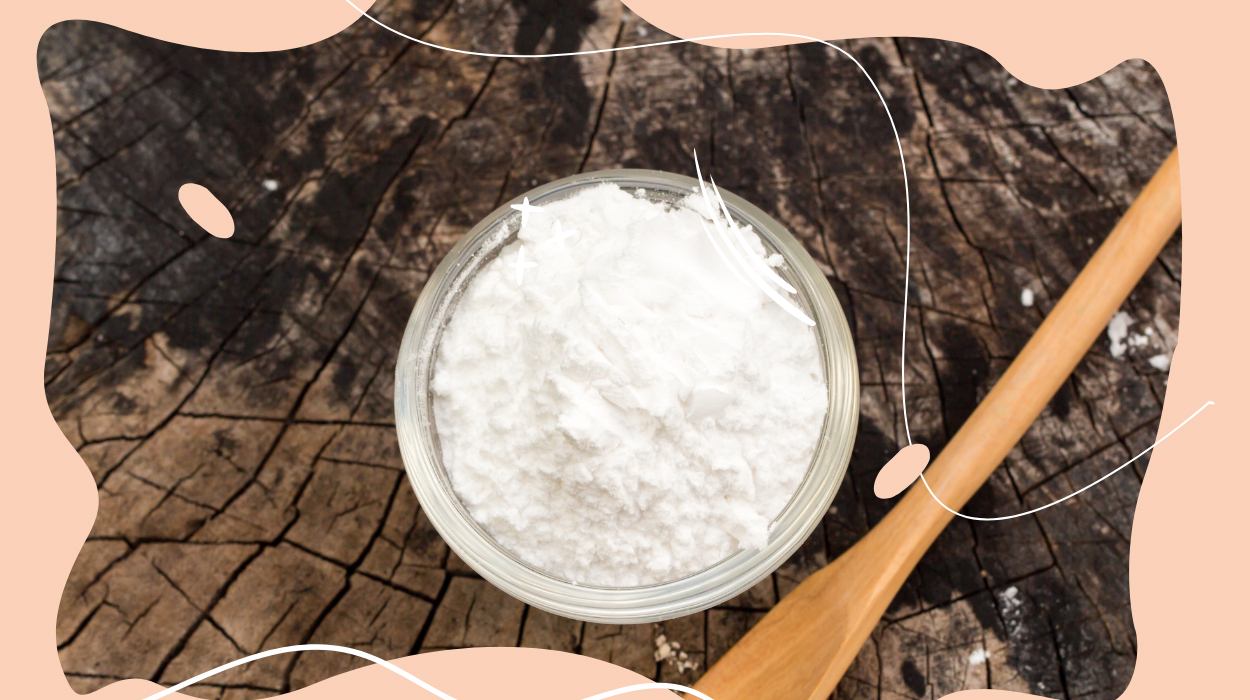 Evidence Based
Evidence Based
Evidence Based
This article is objectively based on relevant scientific literature, written by experienced medical writers, and fact-checked by a team of degreed medical experts.
Our team of registered dietitian nutritionists and licensed medical professionals seek to remain objective and unbiased while preserving the integrity of any scientific debate.
The articles contain evidence-based references from approved scientific sites. The numbers* in parentheses (*1,2,3) will take you to clickable links to our reputable sources.
Is Baking Powder Gluten-Free? Find Out In 2024

Baking powder helps baked goods rise[1] to achieve a light, fluffy consistency. For individuals following a gluten-free lifestyle, it’s crucial to ascertain whether a baking powder is gluten-free and safe to use.
Gluten, a protein found in wheat, barley, and rye,[2] can cause adverse reactions in those with gluten sensitivities or celiac disease. This article will investigate whether baking powder is gluten-free.
Let’s explore if there is gluten in baking powder and how to navigate the world of gluten-free baking powder options and alternatives
Is Baking Powder Gluten Free?
In most cases, baking powder is gluten-free. Gluten is a protein found in wheat, barley, and rye and is typically not added to baking powder.
The primary ingredients in baking powder are baking soda, cream of tartar, and a moisture-absorbing agent such as cornstarch. These ingredients are generally gluten-free. But this may not be the case for all baking powder.
It’s important to check the specific brand and product as ingredients can vary. Although rare, some baking powder brands may include gluten-containing ingredients.
Does Baking Powder Contain Gluten?
Baking powder is typically gluten-free as it doesn’t usually contain gluten-containing ingredients.
However, always check the specific brand and product label as ingredients vary. Some baking powder products may include gluten-containing ingredients or become contaminated with gluten during manufacturing.
Manufacturers may include an allergen statement[3] on the product label saying it may contain gluten if they think there’s a risk of gluten contamination, but not always. If there’s no warning, it’s best to contact the manufacturer to be on the safe side.
Why Some Baking Powder Isn’t Free From Gluten
The primary ingredients in baking powder are baking soda and cream of tartar, both of which are gluten-free. However, baking powder usually contains flour or starch to absorb moisture and prevent the ingredients from reacting prematurely. This flour might be derived from wheat.
If the baking powder is produced in a facility that also handles gluten-containing products, there is also a risk of cross-contamination.[4]
If you follow a gluten-free diet plan, carefully check the product label for gluten-derived ingredients or contamination risk warnings. If you’re still unsure, contact the manufacturer to ensure the baking powder is safe.
Fortunately, there are gluten-free baking powder options available so you can bake cakes, pastries, and healthy gluten-free breakfast goodies without worry.
What Is Baking Powder?
Baking powder plays a fundamental role[1] in baking by facilitating the expansion and rising of dough or batter. It’s a mixture containing three main components:
- A base, usually baking soda.
- An acid, usually cream of tartar.
- A moisture-absorbing agent like cornstarch.
A chemical reaction occurs when moisture and heat come into contact with baking powder. The acid reacts with the baking soda and moisture to release carbon dioxide gas. This gas forms bubbles in the dough or batter causing it to expand and rise.[5]
Baking Powder Vs. Baking Soda
Although they both play a role in leavening, baking powder is different from baking soda.
Baking soda, or sodium bicarbonate,[6] requires an acidic ingredient in the baking recipe to activate it. Baking powder is made with baking soda plus an acid component,[7] eliminating the need for acidic ingredients.
So, baking soda can be used in recipes with acidic ingredients rather than baking powder, while the latter is used for non-acidic recipes.
Double-Acting Baking Powder
There are various types of baking powder available, including acting and double-acting options.
Regular, or acting, baking powder releases gas soon as it gets wet. Conversely, double-acting baking powder[8] releases gas in two steps:
- First, when it gets moist.
- Second, when it’s heated during baking.
Tips For Buying Gluten-Free Baking Powder
Not all baking powder is gluten-free, so you must be careful when buying it. Follow these tips when buying gluten-free baking powder:
- Look for clear labeling: Gluten-free should be stated on the packaging.[9]
- Check for certifications: Look for reputable gluten-free certifications on the packaging.
- Read the ingredient list: Ensure no gluten-containing additives or fillers are present.
- Seek recommendations: Ask registered dietitian professionals or trusted individuals who follow a gluten-free diet for their preferred brands.
- Consider reputable brands: Choose well-established brands known for their gluten-free products.
- Check online resources: Explore websites or forums dedicated to gluten-free living.
How To Make Your Own Gluten-Free Baking Powder
If you prefer to make your gluten-free baking powder at home, you can do so with a few simple ingredients. Here’s a recipe to make gluten-free baking powder:
Ingredients:
- Baking soda.
- Cream of tartar.
- Corn starch or another gluten-free starch such as potato or wheat starch.
Instructions:
- Start by measuring out the desired amount of each ingredient. Ensure to maintain the correct ratio of baking soda, cream of tartar, and starch.
- Next, combine the ingredients in a bowl. Mix thoroughly until well combined to ensure the ingredients are evenly distributed.
- Transfer your mixture to a clean and dry airtight container for storage. Ensure the container is tightly sealed.
- Don’t forget to label the container with both the date and contents so you can keep track of its freshness.
- Store your baking powder away from any moisture or direct sunlight. If stored properly, it should remain fresh and usable for months.
Consult the recipe and adjust measurements accordingly. The amount of baking powder required varies depending on the desired rise and texture of the baked goods.
You can also use baking soda and buttermilk as a one-off in individual recipes, but this cannot be stored for later use as it is wet.
When using your homemade gluten-free baking powder in recipes, remember that it may have a slightly different flavor or leavening power compared to commercial baking powders.
The Bottom Line
Does baking powder have gluten? No, baking powder is usually gluten-free and considered safe for those following a free diet. Baking powder ingredients include baking soda, cream of tartar, and a moisture-absorbing agent like cornstarch.
Nonetheless, it’s important to check the label or contact the manufacturer to confirm whether a particular brand is gluten-free, as formulations may differ. Some moisture-absorbing agents might come from wheat flour, which contains gluten.
When following a gluten-free diet, also be mindful of other products you consume, such as protein powders, fat burners, and vitamins. If finding gluten-free eating challenging, try using gluten-free meal replacement or a gluten-free meal delivery service.
Frequently Asked Questions
Baking powder combines baking soda, an acid – usually cream of tartar – and a moisture-absorbing agent – usually starch or flour. Baking soda requires an acidic ingredient to activate it; baking powder already contains the acid needed for leavening.
Baking powder is important for gluten-free baking as it provides the necessary rise and texture without gluten. It helps create light and fluffy baked goods by releasing carbon dioxide gas during baking, creating bubbles.
To determine if baking powder is gluten-free, read the label for indications of gluten-free certifications or allergen warnings. Check the ingredient list for any gluten-containing ingredients like wheat, barley, or rye, or contact the manufacturer for confirmation.
You can use a mixture of 1/4 teaspoon baking soda and an acidic ingredient or 1/2 teaspoon cream of tartar combined with 1/4 teaspoon baking soda. Self-raising gluten-free flour can also be used as a substitute.
Yes, baking powder can lose its effectiveness over time. Check the expiration date on the packaging; if it has expired or is past its recommended shelf life – usually around 6-12 months – it’s best to replace it.
No, baking powder cannot be used as a direct substitute for yeast. Yeast is a living organism that causes the dough to rise over time. Conversely, baking powder provides an instant rise. They have different functions and cannot be used interchangeably.
Homemade baking powder can be as effective as store-bought if made correctly and used within its freshness period. However, store-bought baking powder undergoes rigorous testing and quality control, ensuring consistent results.
+ 9 sources
Health Canal avoids using tertiary references. We have strict sourcing guidelines and rely on peer-reviewed studies, academic researches from medical associations and institutions. To ensure the accuracy of articles in Health Canal, you can read more about the editorial process here
- Eugenia Ayebea Asamoah, Alain Le-Bail, Oge, A., Queveau, D., Olivier Rouaud and Le-Bail, P. (2023). Impact of Baking Powder and Leavening Acids on Batter and Pound Cake Properties. [online] 12(5), pp.946–946. doi:https://doi.org/10.3390/foods12050946.
- Balakireva, A.V. and Zamyatnin, A.A. (2016). Properties of Gluten Intolerance: Gluten Structure, Evolution, Pathogenicity and Detoxification Capabilities. [online] 8(10), pp.644–644. doi:https://doi.org/10.3390/nu8100644.
- Center (2023). Food Allergies. [online] U.S. Food and Drug Administration. Available at: https://www.fda.gov/food/food-labeling-nutrition/food-allergies
- Anil Kumar Verma, Gatti, S., Galeazzi, T., Chiara Monachesi, Padella, L., Giada Del Baldo, R. Annibali, Lionetti, E. and Catassi, C. (2017). Gluten Contamination in Naturally or Labeled Gluten-Free Products Marketed in Italy. [online] 9(2), pp.115–115. doi:https://doi.org/10.3390/nu9020115.
- Garcia-Hernandez, A., C. Roldan-Cruz, Vernon-Carter, E.J. and Alvarez-Ramirez, J. (2021). Effects of leavening agent and time on bread texture and in vitro starch digestibility. [online] doi:https://doi.org/10.1007/s13197-021-05206-1.
- Yang, M., Zhong, X. and Yuan, Y. (2020). Does Baking Soda Function as a Magic Bullet for Patients With Cancer? A Mini Review. [online] 19, p.153473542092257-153473542092257. doi:https://doi.org/10.1177/1534735420922579.
- Manetti, F., Scarpelli, F., Emilia Lucia Belsito, Caputo, P., Baldino, N., Mincione, A., Leggio, A., Crispini, A., Restuccia, D., Umile Gianfranco Spizzirri and Aiello, F. (2020). Formulation of New Baking (+)-Catechin Based Leavening Agents: Effects on Rheology, Sensory and Antioxidant Features during Muffin Preparation. [online] 9(11), pp.1569–1569. doi:https://doi.org/10.3390/foods9111569.
- Mohammad Khalilian Movahhed, Mohebbi, M., Arash Koocheki and Milani, E. (2016). The effect of different emulsifiers on the eggless cake properties containing WPC. [online] 53(11), pp.3894–3903. doi:https://doi.org/10.1007/s13197-016-2373-y.
- Zysk, W., Dominika Głąbska and Guzek, D. (2019). Role of Front-of-Package Gluten-Free Product Labeling in a Pair-Matched Study in Women with and without Celiac Disease on a Gluten-Free Diet. [online] 11(2), pp.398–398. doi:https://doi.org/10.3390/nu11020398.



